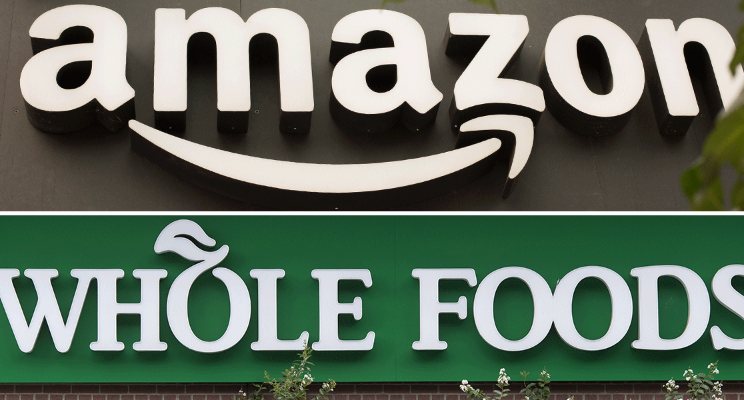The shocking news that Amazon is acquiring Whole Foods for $13.7 billion is a “warning shot across the bow” for its rivals, which now must face one of the most innovative companies as it transforms the grocery industry.
That will be a daunting prospect for many competitors and the wider retail industry, says Bankrate’s senior economic analyst Mark Hamrick, who also believes it will be a big win for consumers (and Amazon shareholders).
“What we’re now trying to come to terms with is what are the possibilities that are presented with this combination? We think about how Amazon will try to integrate some of its best practices that it put in place in the online realm,” Hamrick told LinkedIn. “That includes the computer browser and mobile applications — how that will then infiltrate the experience for the customer in the brick-and-mortar space?”
Amazon cannot continue to command the premium price that Whole Foods has generally been associated with under its “Whole Paycheck” image, which will be revamped to widen its appeal.
“There will be many, many ways that this will present a brand-new world in retail and in grocery shopping, which is at once exciting for consumers, exciting for Amazon shareholders, but also striking fear in the hearts of its rivals and as well as the suppliers, who may be asked to be a little more generous with their pricing because we know Amazon will be very aggressive on price,” Hamrick said. “Whole Foods has very well-heeled customers by and large, but that’s not the market Amazon thinks it can be highly competitive in.”
During an online LinkedIn Live Chat, Hamrick said Amazon will continue to search for strategic opportunities to scale its business, sparking responses from LinkedIn members and experts such as radio host and MOVEN CEO Brett King.
Mark Hamrick: I understand, for example, that Amazon does have a business loan component to help compel small businesses to scale up to conduct sales on their site. So, to the extent that they'll look for strategic opportunities. The potential tension on the payments side is that they don't necessarily want to get into a market where there's a race to the bottom on price/profit margins/cost of transactions.
Brett King: I don't agree - payments are no longer about margin, but frictionless commerce. Margins on payments will disappear. But the value of the rails to execute transactions is why platforms like Alibaba, Taobao, Facebook, Apple and Amazon will fight to be a part of this.
If Amazon doesn't have its own wallet/value store at some stage, I would be very surprised. This is one area where Alibaba has shown the world how it is done.
What do you think? Please share your thoughts by sharing a comment or writing a story using the hashtag #AmazonWholeFoods.
Courtesy of Sam Walden
That will be a daunting prospect for many competitors and the wider retail industry, says Bankrate’s senior economic analyst Mark Hamrick, who also believes it will be a big win for consumers (and Amazon shareholders).
“What we’re now trying to come to terms with is what are the possibilities that are presented with this combination? We think about how Amazon will try to integrate some of its best practices that it put in place in the online realm,” Hamrick told LinkedIn. “That includes the computer browser and mobile applications — how that will then infiltrate the experience for the customer in the brick-and-mortar space?”
Amazon cannot continue to command the premium price that Whole Foods has generally been associated with under its “Whole Paycheck” image, which will be revamped to widen its appeal.
“There will be many, many ways that this will present a brand-new world in retail and in grocery shopping, which is at once exciting for consumers, exciting for Amazon shareholders, but also striking fear in the hearts of its rivals and as well as the suppliers, who may be asked to be a little more generous with their pricing because we know Amazon will be very aggressive on price,” Hamrick said. “Whole Foods has very well-heeled customers by and large, but that’s not the market Amazon thinks it can be highly competitive in.”
During an online LinkedIn Live Chat, Hamrick said Amazon will continue to search for strategic opportunities to scale its business, sparking responses from LinkedIn members and experts such as radio host and MOVEN CEO Brett King.
Mark Hamrick: I understand, for example, that Amazon does have a business loan component to help compel small businesses to scale up to conduct sales on their site. So, to the extent that they'll look for strategic opportunities. The potential tension on the payments side is that they don't necessarily want to get into a market where there's a race to the bottom on price/profit margins/cost of transactions.
Brett King: I don't agree - payments are no longer about margin, but frictionless commerce. Margins on payments will disappear. But the value of the rails to execute transactions is why platforms like Alibaba, Taobao, Facebook, Apple and Amazon will fight to be a part of this.
If Amazon doesn't have its own wallet/value store at some stage, I would be very surprised. This is one area where Alibaba has shown the world how it is done.
What do you think? Please share your thoughts by sharing a comment or writing a story using the hashtag #AmazonWholeFoods.
Courtesy of Sam Walden


 RSS Feed
RSS Feed
